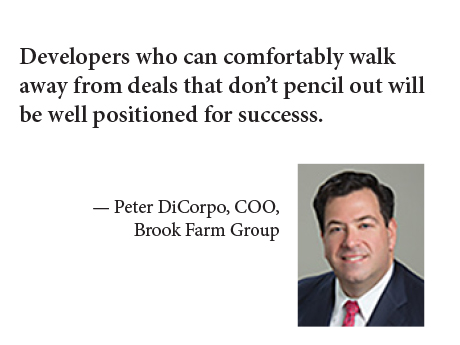— By Peter DiCorpo, COO, Brook Farm Group —
The multifamily sector has been on a tremendous run for more than a decade, attracting record levels of new construction and capital and generating strong rent growth that has occasionally reached into the double digits.
However, given the recent economic and market headwinds, some might conclude that this notable level of activity is over, but that is not the case. Instead, there are clear signs that this sector is poised for long-term growth and will continue to deliver solid returns for years to come.
Developers who can adapt to shifting market conditions, conduct rigorous stress testing of projects and deliver communities that resonate with renters will endure. In some cases, this means identifying growth markets and micro-markets that can support additional development. In the end, those developers who can comfortably walk away from deals that don’t pencil out will be well positioned for success.
Pervasive Housing Shortage Drives Positive Outlook
The central driver of multifamily growth is the incredible level of rental demand across the country. Developers have added 200,000 to 300,000 multifamily units a year nationally since 2010, yet the need for the foreseeable future exceeds these historical deliveries by a significant margin. According to the National Apartment Association (NAA), the rental housing shortage is expected to reach 4.3 million units by 2035. This is due in part to population shifts that are generating an influx of residents in the Southeast and other growth markets. For example, NAA estimates that the Atlanta market alone needs 8,000 new units annually to meet demand.
Across the country, efforts to increase housing supply slowed considerably over the past year as rising interest rates have prompted many lenders to pause overall commercial real estate financing. The Federal Reserve’s recent moderating stance on rate increases has calmed some nerves in the commercial real estate market heading into year-end, but some uncertainty remains. Inflation has decreased in recent months, but remains higher than desired.
The good news is that apartment rentals are expected to perform above average in 2023 despite economic volatility and capital market disruption. New starts for 2023 are projected to be lower than originally expected, however, due to rising capital costs and the pullback in lending. According to CBRE research, strong housing fundamentals should keep occupancy rates around 95 percent and support moderate rent growth, creating an environment that will lead to further development. This is particularly apparent in the Sun Belt and other growth markets that experienced significant population migration during the pandemic.
The recent slowdown in the single family housing market is also moving potential home buyers into the rental housing market. These demand and economic dynamics support a healthy, long-term outlook for the multifamily sector and also provide a buffer against economic disruption.
Developers Need Realistic Approach, Increased Stress Testing
During this time of unprecedented volatility in the economy, developers should adapt a realistic and conservative approach to development planning in order to endure the rapid and drastic changes in market conditions. This includes factoring in higher financing costs and operating expenses, as well as undertaking more detailed stress testing of new projects, from land and construction costs to shifting lending requirements.
The projects that move forward in today’s environment will be more viable and able to deliver desired returns. In essence, the best deals will rise to the top. Also, deals that can pass such new requirements are more likely to deliver favorable results, as they will be coming onto the market at a time of strong demand and limited competition.
The industry faced similar disruption after the global financial crisis when deal flow stalled for many months and then increased again as the market stabilized. The deals that were completed in that environment were the strongest in many years, emerging as finished developments in a period of strong demand and limited competition.
Atlanta Submarket Enjoys Strong Employment Outlook
One example of how micro-market dynamics and good timing can influence success is the upcoming groundbreaking of The Sinclair at Callaway Farms, a 388-unit multifamily community in Covington, Georgia. This rapidly growing submarket of Atlanta is experiencing strong demand and is expected to see an influx of approximately 10,000 new jobs from the medical manufacturing, consumer goods, filming and technology sectors, among others.
Further, the majority of existing multifamily housing in the area was built between 1970 and 1999, and lacks modern features and the amenities typically seen with Class A units. The development is expected to fill demand from current residents as well as the projected influx of new employees moving into the area over the next three years.
By creating this development within an emerging micro-market in Atlanta, Brook Farm Group expects to capitalize on strong rental demand, a lack of modern housing options, and in-bound migration that will support the region’s growing employment base. These are the types of market drivers that can provide solid buffers against shifting economic conditions.
Peter DiCorpo is co-founder and COO of Atlanta-based development firm Brook Farm Group.


